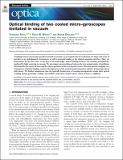Files in this item
Optical binding of two cooled micro-gyroscopes levitated in vacuum
Item metadata
| dc.contributor.author | Arita, Yoshihiko | |
| dc.contributor.author | Wright, Ewan Malcolm | |
| dc.contributor.author | Dholakia, Kishan | |
| dc.date.accessioned | 2018-07-27T15:30:07Z | |
| dc.date.available | 2018-07-27T15:30:07Z | |
| dc.date.issued | 2018-08-20 | |
| dc.identifier | 253477610 | |
| dc.identifier | 722b2477-2274-4bda-8045-7e39f18417c0 | |
| dc.identifier | 85052205894 | |
| dc.identifier | 000442106100003 | |
| dc.identifier.citation | Arita , Y , Wright , E M & Dholakia , K 2018 , ' Optical binding of two cooled micro-gyroscopes levitated in vacuum ' , Optica , vol. 5 , no. 8 , pp. 910-917 . https://doi.org/10.1364/OPTICA.5.000910 | en |
| dc.identifier.issn | 2334-2536 | |
| dc.identifier.uri | https://hdl.handle.net/10023/15723 | |
| dc.description | The authors acknowledge funding from the UK Engineering and Physical Sciences Research Council (EPSRC) Grants EP/J01771X/1 and EP/030017/1. | en |
| dc.description.abstract | Coupling between mesoscopic particles levitated in vacuum is a prerequisite for the realization of a large-scale array of particles in an underdamped environment as well as potential studies at the classical–quantum interface. Here, we demonstrate for the first time, to the best of our knowledge, optical binding between two rotating microparticles mediated by light scattering in vacuum. We investigate autocorrelations between the two normal modes of oscillation determined by the center-of-mass and the relative positions of the two-particle system. The inter-particle coupling, as a consequence of optical binding, removes the degeneracy of the normal mode frequencies, which is in good agreement with theory. We further demonstrate that the optically bound array of rotating microparticles retains their optical coupling during gyroscopic cooling, and exhibits cooperative motion whose center-of-mass is stabilized. | |
| dc.format.extent | 1367164 | |
| dc.language.iso | eng | |
| dc.relation.ispartof | Optica | en |
| dc.subject | QC Physics | en |
| dc.subject | DAS | en |
| dc.subject.lcc | QC | en |
| dc.title | Optical binding of two cooled micro-gyroscopes levitated in vacuum | en |
| dc.type | Journal article | en |
| dc.contributor.sponsor | EPSRC | en |
| dc.contributor.sponsor | EPSRC | en |
| dc.contributor.institution | University of St Andrews. School of Physics and Astronomy | en |
| dc.contributor.institution | University of St Andrews. Biomedical Sciences Research Complex | en |
| dc.identifier.doi | 10.1364/OPTICA.5.000910 | |
| dc.description.status | Peer reviewed | en |
| dc.identifier.grantnumber | EP/J01771X/1 | en |
| dc.identifier.grantnumber | EP/P030017/1 | en |
This item appears in the following Collection(s)
Items in the St Andrews Research Repository are protected by copyright, with all rights reserved, unless otherwise indicated.

